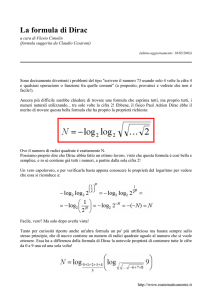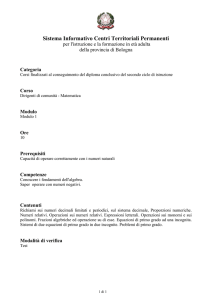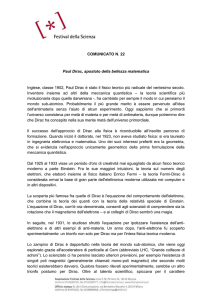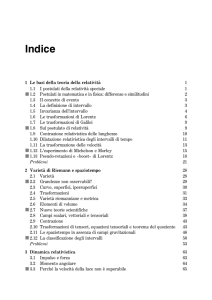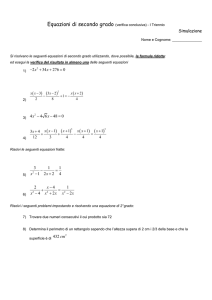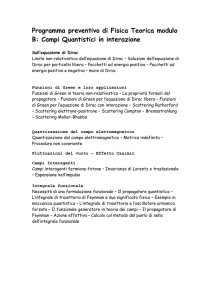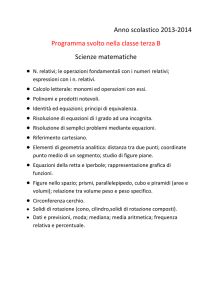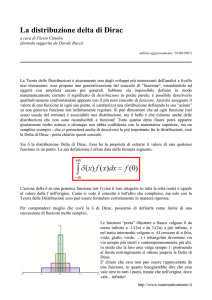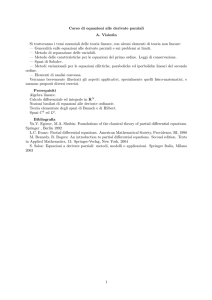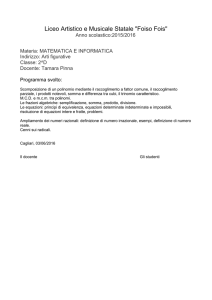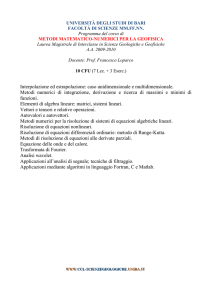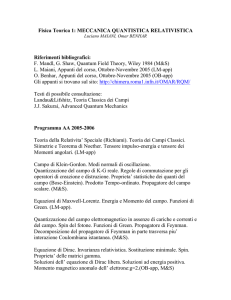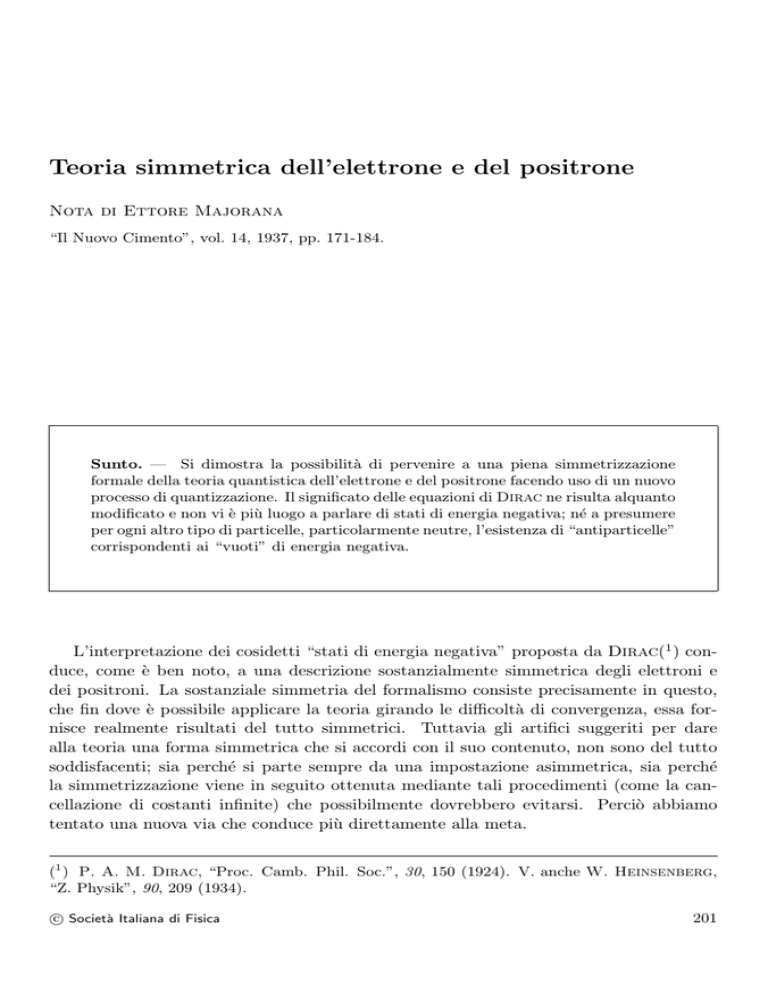
Teoria simmetrica dell’elettrone e del positrone
Nota di Ettore Majorana
“Il Nuovo Cimento”, vol. 14, 1937, pp. 171-184.
Sunto. — Si dimostra la possibilità di pervenire a una piena simmetrizzazione
formale della teoria quantistica dell’elettrone e del positrone facendo uso di un nuovo
processo di quantizzazione. Il significato delle equazioni di Dirac ne risulta alquanto
modificato e non vi è più luogo a parlare di stati di energia negativa; né a presumere
per ogni altro tipo di particelle, particolarmente neutre, l’esistenza di “antiparticelle”
corrispondenti ai “vuoti” di energia negativa.
L’interpretazione dei cosidetti “stati di energia negativa” proposta da Dirac(1 ) conduce, come è ben noto, a una descrizione sostanzialmente simmetrica degli elettroni e
dei positroni. La sostanziale simmetria del formalismo consiste precisamente in questo,
che fin dove è possibile applicare la teoria girando le difficoltà di convergenza, essa fornisce realmente risultati del tutto simmetrici. Tuttavia gli artifici suggeriti per dare
alla teoria una forma simmetrica che si accordi con il suo contenuto, non sono del tutto
soddisfacenti; sia perché si parte sempre da una impostazione asimmetrica, sia perché
la simmetrizzazione viene in seguito ottenuta mediante tali procedimenti (come la cancellazione di costanti infinite) che possibilmente dovrebbero evitarsi. Perciò abbiamo
tentato una nuova via che conduce più direttamente alla meta.
(1 ) P. A. M. Dirac, “Proc. Camb. Phil. Soc.”, 30, 150 (1924). V. anche W. Heinsenberg,
“Z. Physik”, 90, 209 (1934).
c Società Italiana di Fisica
201
202
Nota Scientifica n. 9
Per quanto riguarda gli elettroni e i positroni, da essa si può veramente attendere
soltanto un progresso formale; ma ci sembra importante, per le possibili estensioni analogiche, che venga a cadere la nozione stessa di stato di energia negativa. Vedremo
infatti che è perfettamente possibile costruire, nella maniera più naturale, una teoria
delle particelle neutre elementari senza stati negativi.
1. L’elettrodinamica quantistica si può dedurre, come si sa, mediante un processo
di quantizzazione da un sistema di equazioni che comprende, da una parte, le equazioni
d’onda dell’elettrone di Dirac, dall’altra le equazioni di Maxwell in cui le densità di
carica e di corrente sono rappresentate da certe espressioni formate mediante la funzione
d’onda elettronica. La forma che si dà a queste espressioni aggiunge in realtà qualcosa di
nuovo alle equazioni di Dirac e soltanto da essa può derivare quella asimmetria rispetto
al segno della carica che nelle equazioni di Dirac non esiste. Ma poiché tali espressioni
risultano automaticamente dall’applicazione di un principio variazionale da cui si deducono insieme le equazioni di Maxwell e quelle di Dirac, il nostro problema sarà dunque
di esaminare il fondamento di questo principio e la possibilità di sostituirlo con altro più
appropriato.
Le grandezze che figurano nelle equazioni di Maxwell-Dirac sono notoriamente di due
specie: da una parte si hanno i potenziali elettromagnetici, suscettibili entro i limiti
del principio di corrispondenza di interpretazione classica, dall’altra le onde materiali
che rappresentano particelle obbedienti alla statistica di Fermi e che hanno significato
solo come grandezze quantistiche. In queste condizioni appare poco soddisfacente che
le equazioni e tutto il processo di quantizzazione si facciano dipendere da un principio
variazionale che è soltanto suscettibile di interpretazione classica. Sembra più naturale il
cercare una generalizzazione dei metodi variazionali tale che le variabili le quali figurano
nella funzione Lagrangiana abbiano, come è desiderabile, fin dal principio il loro significato finale; e rappresentino quindi delle grandezze non necessariamente commutabili.
È questa appunto la via che seguiremo. Essa ha importanza sopra tutto per i campi
legati alla statistica di Fermi, mentre per quanto riguarda il campo elettromagnetico
ragioni di semplicità possono far presumere che nulla sia da aggiungere ai vecchi metodi.
Non affronteremo del resto lo studio sistematico delle possibilità logiche offerte dal nuovo
punto di vista in cui ci poniamo, ma ci limiteremo a descrivere un processo di quantizzazione dell’onda materiale che solo sembra avere attualmente importanza applicativa;
esso si presenta come una naturale generalizzazione del metodo di Jordan-Wigner(2 ) e
permette non solo di dare una forma simmetrica alla teoria degli elettroni-positroni, ma
anche di costruire una teoria sostanzialmente nuova per le particelle senza carica elettrica (neutroni e ipotetici neutrini). Per quanto non sia forse ancora possibile chiedere
all’esperienza una decisione fra questa nuova teoria e quella consistente nella semplice
estensione delle equazioni di Dirac alle particelle neutre, va tenuto presente che la prima
introduce, in questo campo ancora poco esplorato, un minor numero di entità ipotetiche.
(2 ) P. Jordan e E. Wigner, “Z. Physik”, 47, 631 (1928).
203
Nota Scientifica n. 9
Lasciando al lettore l’ovvia estensione delle formole seguenti ai sistemi continui di cui
dovremo occuparci in seguito, esponiamo per maggiore chiarezza il metodo di quantizzazione con riferimento ai sistemi discreti. Sia dunque un sistema fisico descritto dalle
variabili reali (matrici simmetriche Hermitiane) q1 q2 , . . . , qn . Definiamo una funzione
Lagrangiana
(1)
L=i
Ars qr q̇s + Brs qr qs ,
r,s
e poniamo
(2)
δ
Ldt = 0,
intendendo che in queste formule Ars e Brs sono numeri reali ordinari, costanti i primi
ed eventualmente dipendenti dal tempo i secondi, e che soddisfano alle relazioni
(3)
Ars = Asr ;
Brs = −Bsr ,
essendo inoltre detArs = 0.
Se le q fossero grandezze commutabili, il principio variazionale (2) non avrebbe alcun significato essendo identicamente verificato. Per grandezze non commutabili la (2)
implica invece l’annullarsi in ogni istante della matrice Hermitiana
i
δqr
r
Ars q̇s + Brs qs
−
s
Ars q̇s + Brs qs δqr = 0,
s
!
comunque si scelgano le variazioni δqr . Questo è possibile solo se le espressioni s (Ars q̇s +
Brs qs ) sono multiple della matrice unità, in modo che con qualche opportuna aggiunta
al principio variazionale (2) (per es. imponendo l’annullarsi della somma dei termini
diagonali(3 ) in tali espressioni) si possono considerare le seguenti come equazioni del
movimento
(4)
Ars q̇s + Brs qs = 0
r = 1, 2, . . . , n.
s
Vogliamo ora mostrare che queste equazioni possono farsi dipendere nel modo consueto
q̇r = −
2πi qr H − Hqr
h
(3 ) L’applicazione fisica che è esposta più avanti suggerisce la restrizione più rigorosa che in
qualunque combinazione lineare delle qr e q̇r con ogni autovalore debba presentarsene un altro
uguale e opposto.
204
Nota Scientifica n. 9
dall’Hamiltoniana
H = −i
(5)
Brs qr qs ,
r,s
la cui forma esatta sarà meglio giustificata in seguito, purché si stabiliscano fra le qr
opportune relazioni di anticommutabilità. Sostituendo nelle (4) mediante le equazioni
successive si trova infatti(∗ )
Brs qs =
s
2π Ars Blm qs ql qm − ql qm qs =
h
s,l,m
2π =
Ars Blm qs ql + ql qs qm − ql qs qm + qm qs =
h
s,l,m
"
2π =
Blm qm
Ars qs ql + ql qs +
Ars qs ql + ql qs qm ,
h
s
s
lm
e basta porre
(6)
s
h
δrl ,
Ars qs ql + ql qs =
4π
perché le (4) siano soddisfatte. Indicando con A−1
rs la matrice inversa di Ars la (6)
può scriversi
(6 )
qr qs + qs qr =
h −1
A .
4π rs
Nel caso speciale che A sia ridotta a forma diagonale
Ars = ar δrs ,
si avrà dunque
(7)
qr q s + q s q r =
h
δrs .
4πar
Passiamo ora ad applicare questo schema alle equazioni di Dirac.
(∗ ) Ne “Il Nuovo Cimento”, nell’ultimo termine dell’equazione prima della parentesi graffa finale
compare erroneamente una parentesi quadra di troppo. (Nota del Curatore.)
205
Nota Scientifica n. 9
2. Dalle equazioni di Dirac senza campo esterno
W
+ (α, p) + βmc ψ = 0,
(8)
c
può notoriamente essere eliminata l’unità immaginaria (e in modo relativisticamente
invariante) con un’opportuna scelta degli operatori α e β. Noi ci riferiremo appunto ad un
sistema di coordinate intrinseche tale che renda le (8) reali, avvertendo espressamente che
le formole a cui perverremo non sono valide, senza opportune modificazioni, in coordinate
generali. Indicando come di consueto, con σx , σy , σz e ρ1 , ρ2 , ρ3 due terne indipendenti
di matrici di Pauli, porremo:
(9)
αx = ρ1 σx ;
αy = ρ3 ;
αz = ρ1 σz ;
β = −ρ1 σy ;
h
con che dividendo le (9) per − 2πi
e ponendovi β = −iβ, µ =
reali
1 ∂
(8 )
− (α, grad) + β µ ψ = 0.
c ∂t
2πmc
h
si hanno le equazioni
In conseguenza le (8) si scindono in due gruppi distinti, di cui l’uno agisce sulla parte
reale, l’altro sulla parte immaginaria di ψ. Poniamo ψ = U + iV e consideriamo le
equazioni reali (8 ) in quanto agiscono sulle U :
1 ∂
− (α, grad) + β µ U = 0.
(10)
c ∂t
Queste equazioni da sole(4 ), cioè senza considerare le equazioni identiche che legano le
V , possono essere ricondotte al principio variazionale esposto anteriormente ed assoggettate al processo di quantizzazione già descritto, mentre nulla di simile potrebbe farsi con
i metodi elementari.
Come principio variazionale da cui dedurre le (10) assumiamo il seguente:
hc ∗ 1 ∂
− (α, grad) + β µ U dqdt = 0.
(11)
δ i U
2π
c ∂t
È facile riconoscere che le condizioni (3) nella loro naturale estensione ai sistemi continui
sono verificate. Seguono in base alle (7) le relazioni di anticommutabilità
(12)
1
Ui (q)Uk q + Uk q Ui (q) = δik δ q − q ,
2
(4 ) Il comportamento delle U per riflessione in un punto dello spazio si può definire convenientemente tenendo presente che, già per altre ragioni, un cambiamento simultaneo di segno delle Ur
non ha significato fisico. Nel nostro schema: U (q) = RU (−q) con R = iρ1 σy e quindi R2 = −1.
Similmente se si inverte l’asse del tempo: U (q, t) = iρ2 U (q, −t).
206
Nota Scientifica n. 9
mentre l’energia diviene, per la (5):
(13)
H=
U ∗ − c(α, p) − βmc2 U dq.
L’invarianza relativistica di (12) e (13) non richiede particolare dimostrazione, poiché
completando tali equazioni con quelle analoghe che si riferiscono alle V , nonché con
le relazioni di anticommutabilità fra le U e le V : Ur (q)Vs (q ) + Vs (q )Ur (q) = 0, si
riottiene null’altro che l’ordinario schema di Jordan-Wigner applicato alle equazioni di
Dirac senza campo. Ma è notevole che la parte di tale formalismo che si riferisce alle
U (o alle V ) possa da sola essere considerata come descrizione teorica, in armonia con i
metodi generali della meccanica quantistica, di un qualche sistema materiale. Il fatto che
tale formalismo ridotto non si adatti alla descrizione degli elettroni positivi e negativi,
può bene essere dovuto alla presenza della carica elettrica e non impedisce l’affermazione
che allo stato attuale delle nostre conoscenze le (12) e (13) costituiscono la più semplice
rappresentazione teorica di un sistema di particelle neutre. Il vantaggio di questo procedimento rispetto alla interpretazione elementare delle equazioni di Dirac è (come vedremo
meglio fra poco) che non vi è più nessuna ragione di presumere l’esistenza di antineutroni
o antineutrini. Questi ultimi vengono in realtà utilizzati nella teoria dell’emissione β
positiva(5 ), ma tale teoria può essere, ovviamente, modificata in modo che l’emissione β,
sia negativa che positiva, venga sempre accompagnata dall’emissione di un neutrino.
In ragione dell’interesse che l’ipotesi suddetta conferisce alle equazioni (12) e (13),
crediamo utile esaminarne da vicino il significato. Sviluppiamo perciò le U nell’interno
di un cubo di lato L secondo il sistema di funzioni periodiche
(14)
1 2πi(γ,q)
e
,
L3/2
n1
n2
,
γy =
,
γx =
γ = γx , γy , γz ;
L
L
n1 , n2 , n3 = 0, ±1, ±2, . . .
fγ (q) =
ponendo
(15)
Ur (q) =
ar (γ)fγ (q).
γ
In conseguenza della realità delle U , sarà
(16)
ar (γ) = ār (−γ).
(5 ) Cfr. G. Wick, “Rend. Accad. Lincei”, 21, 170 (1935).
γz =
n3
:
L
207
Nota Scientifica n. 9
Ponendoci nel caso generale γ = 0, segue dalle (12)
⎧
1
⎪
⎪
⎪
⎨ar (γ)ās (γ) + ās (γ)ar (γ) = 2 δrs ,
ar (γ)as (γ) + as (γ)ar (γ) = 0,
⎪
⎪
⎪
⎩ā (γ)ā (γ) + ā (γ)ā (γ) = 0.
(17)
r
s
s
r
Tutte queste grandezze sono inoltre anticommutabili con le a(γ ) e ā(γ ) per γ diverso
sia da γ che da −γ.
L’energia risulta per la (13):
(18)
H=
4
γ
− hc(γ, αrs ) − mc2 β rs ār (γ)as (γ).
r,s=1
La quantità di moto secondo x corrisponde, come sempre, a meno del fattore
spostamento unitario in tale direzione
(19)
Mx =
U ∗ px U dq =
γ
h
2π i
allo
hγx ār (γ)ak (γ),
r=1
e analogamente per My e Mz .
Per ogni valore di γ figura in (18) una forma Hermitiana che ha
notoriamente due
autovalori positivi e due negativi, tutti uguali in valore assoluto a c m2 c2 + h2 γ 2 .
Possiamo quindi porre in luogo di (18)
(18 )
H=
#
$
c m2 c2 + h2 γ 2 b̄1 (γ)b1 (γ) + b̄2 (γ)b2 (γ) − b̄3 (γ)b3 (γ) − b̄4 (γ)b4 (γ)
γ
essendo le br opportune combinazioni lineari delle ar ottenute per trasformazione unitaria. Risulta inoltre dalla (16) che le br (γ) sono esprimibili linearmente mediante le
b̄r (−γ).
Dal fatto poi che la forma Hermitiana che figura in (18) per un dato valore di γ resta
invariata in virtù di (16) e (17) quando si cambia γ in −γ segue tenendo ancora conto
di (17) che si può porre:
(20)
b3 (γ) = b̄1 (−γ);
b4 (γ) = b̄2 (−γ).
Introducendo per semplicità le nuove variabili
(21)
B1 (γ) =
√
2b1 (γ);
B2 (γ) =
√
2b2 (γ),
208
Nota Scientifica n. 9
otteniamo cosı̀
(22)
(23)
H=
2 1
c m2 c2 + h2 γ 2
nr (γ) −
,
2
γ
r=1
2 1
hγx
nr (γ) −
Mx =
,
2
γ
r=1
essendosi posto
0
rrr
nr (γ) = B̄r (γ)Br (γ) = rMMM
M
1
ed essendo(∗ ) inoltre
⎧
⎪
⎨Br (γ)B̄s (γ ) + B̄s (γ )Br (γ) = δγγ δrs ,
(24)
Br (γ)Bs (γ ) + Bs (γ )Br (γ) = 0,
⎪
⎩
B̄r (γ)B̄s (γ ) + B̄s (γ )B̄r (γ) = 0,
come si otterrebbe formalmente per i coefficienti dello sviluppo di un’onda materiale a
due componenti secondo lo schema di Jordan-Wigner.
Queste formole sono completamente analoghe, salvo la diversa statistica, a quelle che
si ottengono dalla quantizzazione delle equazioni di Maxwell. In luogo di quanti immateriali si hanno particelle con una massa di riposo finita e anche esse con due possibilità
di polarizzazione. Anche qui come nel caso della radiazione, sono presenti i mezzi quanti
di riposo della energia e della quantità di moto, salvo che il loro segno è opposto in
apparente relazione con la diversa statistica. Essi non costituiscono pertanto una difficoltà specifica e allo stato attuale della teoria debbono anche qui essere considerati come
semplici costanti addittive prive di significato.
La descrizione mediante autofunzioni di queste particelle, cosı̀ come dei quanti di luce,
non riesce in modo conveniente, ma nel nostro caso l’esistenza di una massa di riposo permette di considerare l’approssimazione non relativistica, nella quale sono naturalmente
valide tutte le nozioni della meccanica quantistica elementare. Questa approssimazione
può avere interesse pratico sopra tutto nel caso di particelle pesanti (neutroni).
Il mezzo più semplice per passare allo spazio delle configurazioni consiste nell’associare
a un generico oscillatore l’onda piana
1 2πi(γ,q)
e
δσσr ,
L3/2
(r = 1, 2),
(∗ ) Ne “Il Nuovo Cimento” è in realtà scritto “essendosi” e non essendo. (Nota del Curatore in
E. Amaldi, op. cit.)
209
Nota Scientifica n. 9
corrispondente allo stesso valore della quantità di moto e con due possibilità di polarizzazione per tenere conto della molteplicità degli oscillatori. Possiamo andare oltre e
rappresentare con l’autofunzione complessa a due valori Φ = (Φ1 , Φ2 ) non più una sola
particella ma un sistema che ne contenga in numero indeterminato secondo il metodo di
Jordan-Wigner. Basterà allora porre
⎧
1
⎪
Φ1 (q) =
e2πi(γ,q) B1 (γ),
⎪
⎪
3/2
⎨
L
γ
1
⎪
⎪
e2πi(γ,q) B2 (γ).
⎪
⎩Φ2 (q) =
L3/2
(25)
γ
Nell’approssimazione non relativistica (|γ| mc
h ) le costanti br (γ) che figurano
in (18 ) sono combinazioni lineari della ar (γ) con coefficienti indipendenti da γ.
Tali coefficienti dipendono solo dagli elementi di β e in virtù di (9) si può porre
b1 (γ) =
a3 (γ) − ia2 (γ)
√
;
2
b3 (γ) =
a3 (γ) + ia2 (γ)
√
,
2
b2 (γ) =
a4 (γ) + ia1 (γ)
√
;
2
b4 (γ) =
a4 (γ) − ia1 (γ)
√
,
2
con che anche le (20), a causa di (16), sono soddisfatte. Dalle (15) e (25) segue dunque
per l’approssimazione non relativistica:
(26)
Φ1 (q) = U3 (q) − iU2 (q),
Φ2 (q) = U4 (q) + iU1 (q).
Notiamo la circostanza,
di interesse puramente formale, che Φ = (Φ1 , Φ2 ) coincide a
√
meno del fattore 2 con la coppia di componenti grandi delle autofunzioni appartenenti
alle equazioni (10), interpretate nel modo consueto, senza cioè restrizioni di realità. Per
1−ρ σ
dimostrarlo basta verificare che la trasformazione ψ = √22 y U permette di passare dallo
schema (9) a quello usuale di Dirac (α = ρ1 σ; β = ρ3 ) e che risulta effettivamente
1
ψ3 = √ Φ1 ,
2
1
ψ4 = √ Φ2 ;
2
in tale schema sono infatti notoriamente ψ3 e ψ4 le componenti grandi. Questo avvicinamento, se chiarisce la legge di trasformazione di Φ di fronte alle rotazioni nello spazio,
cessa naturalmente di avere significato in rapporto alle trasformazioni generali di Lorentz.
L’esistenza di formole semplici come le (26), potrebbe fare ritenere superfluo, almeno
fino a una certa approssimazione, il passaggio attraverso le onde piane. In realtà tale
passaggio è sempre concettualmente necessario per ottenere la cancellazione dei mezzi
210
Nota Scientifica n. 9
quanti di riposo. Dopo tale cancellazione l’espressione dell’energia è infatti naturalmente
in prima approssimazione
(27)
H=
1 2
Φ̃ mc +
p Φdq,
2m
2
e differisce quindi in modo essenziale dalla (13).
3. Come abbiamo già detto, lo schema (12) non è sufficiente per la descrizione di particelle cariche; ma l’aggiunta di una seconda quaterna di grandezze reali Vr analoghe alle
Ur permette di riottenere l’ordinaria elettrodinamica in una forma simmetrica rispetto
all’elettrone e al positrone. Consideriamo dunque due serie di grandezze reali rappresentanti rispettivamente le particelle materiali e il campo elettromagnetico. Le grandezze
della prima specie vanno interpretate secondo lo schema esposto al n. 1, mentre quelle
della seconda serie, e cioè i potenziali elettromagnetici ϕ e A = (Ax , Ay , Az ) possono
intendersi come grandezze classiche quantizzate secondo la regola di Heisenberg fondata
sul principio di corrispondenza. L’insieme delle equazioni di Maxwell e Dirac si potrà
ottenere (con l’accennata restrizione per quanto riguarda le seconde) da un principio
variazionale(∗ )
δ
Ldqdt = 0
risultando L dalla somma di tre termini
L = L + L + L
di cui il primo è relativo all’onda materiale
(28)
hc
L =i
2π
% ∗ 1 ∂
− (α, grad) + β µ U +
U
c ∂t
&
1 ∂
− (α, grad) + β µ V ,
+V ∗
c ∂t
e il secondo si riferisce al campo di radiazione che supponiamo quantizzato secondo il
metodo di Fermi(6 )
(29)
1
1 2
E − H2 −
L =
8π
8π
2
1
ϕ̇ + div A .
c
(∗ ) Ne “Il Nuovo Cimento” manca erroneamente il membro di destra dell’equazione “= 0”.
(Nota del Curatore, si veda anche E. Amaldi, op. cit.)
(6 ) E. Fermi, “Rend. Accad. Lincei”, 9, 881 (1929).
211
Nota Scientifica n. 9
Bisogna quindi imporre la condizione aggiunta
1
ϕ̇ + div A = 0.
c
(30)
L’espressione (29) differisce in realtà da quella usata originariamente da Fermi, ma
solo per termini integrabili. Essa conduce a una definizione del momento P0 coniugato a
ϕ tale da permettere l’immediata eliminazione di una delle due onde longitudinali senza
passare per lo sviluppo secondo le onde piane; è a questo riguardo del tutto indifferente
che il secondo termine nell’espressione (29) di L venga moltiplicato per una costante
arbitraria diversa da zero.
Quanto al termine L , esso va scelto in modo che ψ = U +iV obbedisca alle equazioni
di Dirac (8) completate con l’introduzione del campo esterno, cioè alle equazioni:
W
e
e + ϕ + α, p + A + βmc ψ = 0.
c
c
c
Questo praticamente obbliga a porre
(31)
L = ieU ∗ [ϕ + (α, A)]V − ieV ∗ [ϕ + (α, A)]U.
Dalla variazione dei potenziali elettromagnetici si deducono allora le seguenti espressioni per le densità di carica e di corrente
(32)
⎧
ψ̃ψ − ψ ∗ ψ̄
⎪
⎪
,
⎨ρ = −ie(U ∗ V − V ∗ U ) = −e
2
∗
⎪
⎪
⎩I = ie(U ∗ αV − V ∗ αU ) = e ψ̃αψ − ψ αψ̄ .
2
Queste espressioni differiscono da quelle consuete solo per costanti infinite. La cancellazione di tali costanti infinite è richiesta dalla simmetrizzazione della teoria che è già
implicita nella forma scelta per il principio variazionale; infatti lo scambio di Ur e Vr ,
che entrano simmetricamente in L , equivale appunto a un cambiamento di segno della
carica elettrica.
Le U e V obbediscono alle relazioni di anticommutabilità
1
δ(q − q )δrs ,
2
1
Vr (q)Vs (q ) + Vs (q )Vr (q) = δ(q − q )δrs ,
2
Ur (q)Us (q ) + Us (q )Ur (q) =
Ur (q)Vs (q ) + Vs (q )Ur (q) = 0,
equivalenti all’ordinario schema di Jordan-Wigner quando si faccia ψ = U + iV . I potenziali elettromagnetici ϕ, Ax , Ay , Az e i loro momenti coniugati soddisfanno invece alle
212
Nota Scientifica n. 9
ordinarie relazioni di commutabilità, ad esempio P0 (q)ϕ(q ) − ϕ(q )P0 (q) =
essendo ora
(33)
⎧
1
1
⎪
⎪
⎨P0 = − 4πc c ϕ̇ + div A ,
⎪
1
⎪
⎩P = − 1 E ;
Ey ;
Py = −
x
x
4πc
4πc
Pz = −
h
2πi δ(q
− q )
1
Ez .
4πc
L’energia consta di tre parti: H = H + H + H . Il primo termine H si deduce
da L 'secondo le regole già esposte. Il secondo si ottiene secondo le regole classiche
H = [P0 ϕ̇ + (P, A) − L ]dq, essendosi posto P = (Px , Py , Pz ). Quanto al termine H ,
esso si può dedurre
' da L seguendo indifferentemente l’uno o l’altro metodo (nel nostro
caso H = − L dq) e cosı̀ deve essere dato che L è funzione tanto delle grandezze
di campo materiali che di quelle elettromagnetiche. Questo prova d’altronde la necessità
della posizione (5). L’equazione di continuità (30) è valida sempre purché sia soddisfatta
inizialmente insieme con l’equazione della divergenza div E = 4πρ. Segue, per le (33), che
la cinematica definita dalle relazioni di scambio deve essere ridotta mediante le equazioni
⎧
⎨P0 (q) = 0,
(34)
⎩div P + 1 ρ = 0,
c
e quindi mediante la fissazione di due grandezze di campo e conseguente indeterminazione delle coniugate. La prima delle (34) importa dunque l’eliminazione di P0 e di ϕ
dall’espressione di H. Tale eliminazione si ottiene facilmente facendo uso delle (33) e si
giunge cosı̀ alla formola
(35)
&
%
2
1 2
2
H=
ψ̃ − c(α, p) − βmc ψ − (A, I) + 2πcP +
rot A
dq.
8π
Circa la questione dell’invarianza relativistica, osserviamo che le ψ = U + iV soddisfano alle equazioni di Dirac, mentre le equazioni di Maxwell continuano anche esse a
valere con espressioni delle densità di carica e di corrente che obbediscono alla legge di
trasformazione relativistica. Queste due circostanze assicurano che la dimostrazione completa dell’invarianza della teoria è già implicita nei risultati di Heisenberg e Pauli(7 ).
Passiamo ora all’interpretazione del formalismo.
4. Sviluppando la U , e analogamente la V , secondo il sistema di funzioni periodiche
già considerato, troviamo come ovvia estensione della (22), dopo la cancellazione dei
(7 ) W. Heisenberg e W. Pauli, “Z. Physik”, 56, 1 (1929); 59, 168 (1930).
213
Nota Scientifica n. 9
mezzi quanti di riposo
H =
(36)
2
B̄r (γ)Br (γ) + B̄r (γ)Br (γ) ,
c m2 c2 + h2 γ 2
γ
r=1
riferendosi le Br e Br rispettivamente allo sviluppo delle U e V ; le Br e Br e le loro
coniugate obbediscono alle consuete relazioni di anticommutabilità. Introducendo, per
ogni valore di γ, quattro opportune funzioni di spin ξs (γ) (s = 1, 2, 3, 4) a quattro valori
complessi e formanti un sistema unitario, si potrà porre
⎧
)
1 (
⎪
√
U
=
B1 (γ)ξ1 (γ) + B2 (γ)ξ2 (γ) + B̄1 (−γ)ξ3 (γ) + B̄2 (−γ)ξ4 (γ) fγ (q),
⎪
⎪
⎨
2
(37)
γ
)
1 ( ⎪
⎪
B1 (γ)ξ1 (γ) + B2 (γ)ξ2 (γ) + B̄1 (−γ)ξ3 (γ) + B̄2 (−γ)ξ4 (γ) fγ (q),
⎪
⎩V = √2
γ
essendo inoltre soddisfatte le relazioni
ξ3 (γ) = ξ¯1 (−γ),
(38)
ξ4 (γ) = ξ¯2 (−γ).
Dall’espressione (32) della densità di elettricità segue per la carica totale
Q=−
(39)
=−
ie
2
∗
U (q)V (q) − V ∗ (q)U (q) dq =
2
ie Br (γ)B̄r (γ) + B̄r (γ)Br (γ) − B̄r (γ)Br (γ) − Br (γ)B̄r (γ) .
2 γ r=1
Se si pone
Crel =
(40)
Br + iBr
√
;
2
Crpos =
Br − iBr
√
2
le espressioni (36) e (39) dell’energia e della carica si possono portare nella forma
(41)
H =
2 C̄rel Crel + C̄rpos Crpos
c m2 c2 + h2 γ 2
γ
(42)
Q=e
2 r=1
− C̄rel Crel −
γ
r=1
=e
2 γ
r=1
1
2
+ C̄rpos Crpos −
− C̄rel Crel + C̄rpos Crpos .
1
=
2
214
Nota Scientifica n. 9
L’eliminazione dei mezzi quanti di riposo di elettricità avviene dunque automaticamente purché, bene inteso, si esegua prima la sommatoria interna. L’insieme di (41)
e (42) rappresenta oscillatori equivalenti a un doppio sistema di particelle obbedienti alla
statistica di Fermi con la massa di riposo m e la carica ±e; le variabili Crpos si riferiscono
ai positroni e le Crel agli elettroni.
L’eliminazione del campo elettrico longitudinale mediante la seconda delle (34) presenta difficoltà in una teoria simmetrica per l’impossibilità di porre ρ, quale risulta
da (32), in forma diagonale. Il risultato dell’eliminazione è ben noto (per quanto parzialmente illusorio per difficoltà di convergenza) nell’elettrodinamica ordinaria in cui si pone
ρ = −eψ̃ψ; ma esso è egualmente noto se si parte da ρ = eψ ∗ ψ̄ poiché quest’ultima
posizione equivale interamente a invertire l’ufficio dell’elettrone e del positrone, considerando quest’ultimo come particella reale e l’elettrone come “vuoto” di positrone.
Sembra plausibile che quegli elementi di matrice che risultassero della stessa forma in
tali teorie opposte, si debbono conservare nella teoria simmetrica. Supponiamo dunque
di aver proceduto alla eliminazione della parte irrotazionale di A e P .
L’espressione (35) di H verrà modificata in due modi: in primo luogo intendendo che
A e P in questa espressione rappresentino solo la parte priva di divergenza di tali vettori; e
in secondo luogo aggiungendo un termine che rappresenta l’energia elettrostatica. Questo
termine ha una forma differente nella teoria ordinaria (elettrone-vuoto di elettrone) e in
quella opposta. Nella prima si ha conservando l’interazione di ogni particella con se
stessa
1
e2
Hels =
ψ̃(q)ψ(q)ψ̃ q ψ q dqdq ,
2
|q − q |
e nella seconda
Hels
e2
=
2
1
ψ ∗ (q)ψ̄(q)ψ ∗ q ψ̄ q dqdq .
|q − q |
Mediante le (37) e (40) si può esprimere l’energia elettrostatica in funzione delle C.
I soli termini elettrostatici che hanno ricevuto applicazione fisica sono peraltro identici
nelle due teorie; essi sono quelli che dal punto di vista corpuscolare si lasciano interpretare
come repulsione o attrazione fra particelle distinte della stessa specie o di specie differente.
Per quanto infine concerne l’interazione con il campo di radiazione, l’unica differenza
fra la teoria simmetrica e quella ordinaria riguarda la cancellazione di costanti di risultante indeterminata, relative ai singoli oscillatori, nell’espressione della densità di corrente; anche qui rimangono invariate le formole di interesse applicativo.
Nota Scientifica n. 9
215
Commento alla Nota Scientifica n. 9 : “Teoria simmetrica dell’elettrone e del
positrone”.
Scritto nel 1937, un anno prima della sua tragica scomparsa, questo lavoro rappresenta
probabilmente il contributo più duraturo di Ettore Majorana alla Fisica moderna. Il
lavoro è scritto in un italiano elegante e conciso (la traduzione in inglese è risultata più
lunga del testo originale) ed affronta il problema di formulare la teoria di Dirac eliminando
del tutto l’armamentario degli stati ad energia negativa.
Nella usuale formulazione, si parte da una situazione altamente asimmetrica tra elettroni e positroni, per arrivare solo alla fine a scoprire che le due particelle sono perfettamente simmetriche tra loro. La simmetria elettrone-positrone è talmente poco evidente
che lo stesso Dirac, nella sua prima formulazione, aveva proposto di identificare le particelle positive, le lacune, con il protone.
Riferendosi alla formulazione originale, Majorana nota che
“. . . gli artifici suggeriti per dare alla teoria una forma simmetrica che si accordi con
il suo contenuto, non sono del tutto soddisfacenti; sia perché si parte sempre da una impostazione asimmetrica, sia perché la simmetrizzazione viene in seguito ottenuta mediante
tali procedimenti (come la cancellazione di costanti infinite) che possibilmente dovrebbero
evitarsi. Perciò abbiamo tentato una nuova via che conduce più direttamente alla meta.”
Partendo da queste premesse, Majorana delinea una teoria di campo basata su variabili anticommutanti, prive quindi di analogia classica, e deriva l’equazione di Dirac da
un principio variazionale.
L’elettrone è rappresentato da un campo complesso, che si può decomporre in parte
reale e parte immaginaria. Tuttavia, nella particolare rappresentazione delle matrici
di Dirac in cui esse sono tutte immaginarie (da allora nota come rappresentazione di
Majorana) ciascuna delle due componenti può, separatamente, “essere considerata come
una descrizione teorica, in armonia con i metodi generali della meccanica quantistica, di
un qualche sistema materiale”.
Naturalmente, Majorana riconosce prontamente che per l’elettrone, che possiede una
carica elettrica conservata, non si può fare a meno di considerare le due componenti allo
stesso tempo. Ma l’economicità dello schema lo porta naturalmente a supporre che esso
possa trovare applicazione per le particelle neutre.
“Il vantaggio di questo procedimento. . . è che non vi è più nessuna ragione per presumere l’esistenza di antineutroni o antineutrini. Questi ultimi vengono in realtà utiliz-
216
Nota Scientifica n. 9
zati nella teoria dell’emissione β positiva, ma tale teoria può essere ovviamente modificata in modo che l’emissione β, sia positiva sia negativa, venga sempre accompagnata
dall’emissione di un neutrino.”
Majorana si riferisce qui alla teoria dei raggi β positivi, formulata appena due anni
prima, sempre a Roma, da Giancarlo Wick.
Dalla riformulazione della teoria di Dirac emerge una possibilità fisica del tutto inattesa, che da allora è stata oggetto di scrutinio sperimentale e teorico, ed alla quale non
siamo riusciti ancora a dare una risposta.
La proposta del neutrino di Majorana ha avuto sorti alterne e si è intrecciata con la
“teoria a due componenti” del neutrino formulata da Herman Weyl qualche anno prima,
nel 1929.
È un fatto che le particelle emesse nei decadimenti β negativi e in quelli β positivi si
comportano diversamente: nella loro interazione con i nuclei atomici i primi producono
solo positroni, ed i secondi solo elettroni. Tuttavia, la forma V − A dell’interazione e la
teoria di Weyl permettono di associare questa differenza alla differenza di elicità delle
due particelle.
Poiché l’elicità è conservata per una particella di massa nulla, deviazioni da questo
comportamento si avrebbero solo per termini dell’ordine del rapporto (massa del neutrino)/(energia del neutrino), che assume valori completamente trascurabili nelle reazioni
iniziate da neutrini.
La natura di Majorana del neutrino si può mettere alla prova con l’osservazione dei
decadimenti doppio-β senza neutrino. Sono processi di secondo ordine nell’interazione di
Fermi. Nel primo passo viene emesso, insieme ad un elettrone, un neutrino virtuale con
elicità positiva, che successivamente viene assorbito come se fosse un neutrino (elicità
negativa), con emissione di un secondo elettrone. Il processo complessivo, N ∗ → N + 2e,
viola la conservazione del numero leptonico ed ha un’ampiezza proporzionale alla massa
di Majorana del neutrino. La sua esistenza sarebbe la prova evidente che “non vi è
alcuna ragione per presumere. . . l’esistenza di. . . antineutrini.”
Rimasta a lungo come una possibilità alquanto esotica, il neutrino di Majorana è
emerso, ai nostri giorni, come la spiegazione più naturale della piccolissima massa del
neutrino.
Inoltre, l’assenza di un numero leptonico conservato, L, analogo alla carica
dell’elettrone, permette di speculare che proprio il decadimento di neutrini di Majorana super-pesanti abbia dato luogo, nell’Universo primordiale, ad un’asimmetria in L,
trasformata poi, in virtù della stretta conservazione della combinazione B − L (B =
numero barionico), nell’asimmetria materia-antimateria del nostro Universo.
In diversi laboratori sotterranei in giro per il mondo si è cercato di mettere in evidenza
il decadimento doppio-β senza neutrini, finora senza successo. Presso i Laboratori del
Gran Sasso dell’INFN è in preparazione un esperimento di dimensioni mai raggiunte
prima, CUORE, che dovrebbe porre limiti molto stringenti al processo doppio β,. . .
oppure osservarlo.
Nota Scientifica n. 9
217
Mi piace pensare che proprio nel nostro Paese si possa rispondere affermativamente
alla domanda posta sul tappeto da Majorana più di mezzo secolo fa, e dare allo
stesso tempo una possibile spiegazione alla preponderanza della materia sull’antimateria
nell’Universo, da cui è dipesa la nostra stessa esistenza.
Luciano Maiani
Università di Roma “La Sapienza”
A symmetric theory of electrons and positrons(∗ )
Ettore Majorana
Summary. — It is shown that it is possible to achieve complete formal symmetrization in the electron and proton quantum theory by means of a new quantization process. The meaning of Dirac equations is somewhat modified and there is no longer
any reason to speak of negative-energy states nor to assume, for any other types
of particles, especially neutral ones, the existence of antiparticles, corresponding to
the “holes” of negative energy.
The interpretation of the so-called “negative energy states” proposed by Dirac(1 )
leads, as is well known, to a substantially symmetric description of electrons and
positrons. The substantial symmetry of the formalism consists precisely in that the
theory itself gives completely symmetric results, whenever it is possible to apply it while
overcoming divergence problems.
The prescriptions needed to cast the theory into a symmetric form, in conformity
with its content, are however not entirely satisfactory, because one always starts from
an asymmetric form or because symmetric results are obtained only after one applies
appropriate procedures, such as the cancellation of divergent constants, that one should
(∗ ) Translated from “Il Nuovo Cimento”, vol. 14, 1937, pp. 171-184, by Luciano Maiani in
“Soryushiron Kenkyu”, 63 (1981) 149-462. (Courtesy of L. Maiani.) The present translation has
been revised by the Editor with the addition of the summary which was missing in “Soryushiron
Kenkyu”.
(1 ) P. A. M. Dirac, “Proc. Camb. Phil. Soc.”, 30, 150 (1924). See also W. Heinsenberg,
“Z. Physik”, 90, 209 (1934).
218
c Società Italiana di Fisica
Scientific Paper no. 9
219
possibly avoid. For these reasons, we have attempted a new approach, which leads more
directly to the desired result.
In the case of electrons and positrons, we may anticipate only a formal progress; but
we consider it important, for possible extensions by analogy, that the very notion of
negative energy states can be avoided. We shall see, in fact, that it is perfectly, and most
naturally, possible to formulate a theory of elementary neutral particles which do not
have negative (energy) states.
1. It is well known that quantum electrodynamics can be deduced by quantizing
a system of equations which include the Dirac wave equations for the electron and
the Maxwell equations. In the latter, the charge density and current are represented
by certain expressions containing the electron wave function. The form given to these
expressions adds, in reality, something new because it allows to derive the asymmetry
with respect to the sign of the electric charge, an asymmetry which is not present in the
Dirac equations. These expressions can be derived directly from a variational principle,
which yields the Maxwell and the Dirac equations at the same time. Therefore, our first
problem will be to examine the foundation of the variational principle itself, and the
possibility of replacing it with a more appropriate one.
The Maxwell-Dirac equations contain quantities of two different types. On the one
side, we have the electromagnetic potentials, which can be given a classical interpretation, within the limits posed by the correspondence principle. On the other side, there
are the matter waves, which represent particles obeying the Fermi Statistic, and which
have only a quantum interpretation. In this respect, it seems little satisfactory that the
equations as well as the whole quantization procedure have to be derived from a variational principle which can be given only a classical interpretation. It seems more natural
to search for a generalization of the variational method, such that the variables appearing
in the Lagrange function assume, from the very beginning, their final significance, and,
therefore, represent not necessarily commuting quantities.
This is the approach we shall follow. This approach is most important for fields
obeying the Fermi statistics; reasons of simplicity may indicate, on the other hand, that
nothing has to be added to the old method in the case of the electromagnetic field. In
fact, we shall not perform a systematic study of all the logical possibilities offered by
the new point of view we are adopting. Rather, we limit ourselves to the description
of a quantization procedure for the matter-waves, which is the only important case for
applications, at present; this method appears as a natural generalization of the JordanWigner method(2 ), and it allows not only to cast the electron-positron theory into a
symmetric form, but also to construct an essentially new theory for particles not endowed
with an electric charge (neutrons and the hypothetical neutrinos). Even though it is
perhaps not yet possible to ask experiments to decide between the new theory and a
simple extension of the Dirac equations to neutral particles, one should keep in mind
(2 ) P. Jordan and E. Wigner, “Z. Physik”, 47, 631 (1928).
220
Scientific Paper no. 9
that the new theory introduces a smaller number of hypothetical entities, in this yet
unexplored field.
Leaving to the reader the obvious extension of the formulae to the continuous systems,
which we shall consider later on, we illustrate in the following the quantization procedure
for discrete systems. Let a physical system be described by the real variables q1 q2 , . . . , qn
(symmetric, Hermitian matrices). We define a Lagrange function:
(1)
L=i
Ars qr q̇s + Brs qr qs ,
r,s
and set:
(2)
δ
Ldt = 0,
we understand that Ars and Brs are ordinary real numbers, constant the former and,
eventually, time-dependent the latter, which obey the relations:
(3)
Ars = Asr ;
Brs = −Bsr ,
and, furthermore, with detArs = 0.
If the q’s were ordinary, commuting, variables, the variational principle (2) would
have no meaning because it would be identically satisfied. In the case of non-commuting
variables, eq. (2) implies the vanishing, at any time, of the Hermitian matrix:
i
δqr
r
Ars q̇s + Brs qs
−
s
Ars q̇s + Brs qs δqr = 0,
s
!
for arbitrary variations δqr . This is only possible if the expression s (Ars q̇s + Brs qs ) are
multiple of the unit matrix so that, after some appropriate modification of the variational
principle (2) (e.g. by requiring the sum of the diagonal terms in the above expressions
to vanish(3 )) we may consider the following equations of motion:
(4)
Ars q̇s + Brs qs = 0
r = 1, 2, . . . , n.
s
We now show that these equations can be derived, following the usual procedure:
q̇r = −
2πi qr H − Hqr
h
(3 ) The physical application which will be illustrated later on suggests the more rigorous restriction that, in any linear combination of qr and q̇r to any given eigenvalue there corresponds
another one, equal in absolute value and opposite in sign.
221
Scientific Paper no. 9
from the Hamiltonian:
H = −i
(5)
Brs qr qs ,
r,s
(whose exact form will be better justified in the following) provided we assume suitable
anticommutation relations for the qr . Substituting in eq. (4) the successive equations,
one finds:
Brs qs =
s
2π Ars Blm qs ql qm − ql qm qs =
h
s,l,m
2π =
Ars Blm qs ql + ql qs qm − ql qs qm + qm qs =
h
s,l,m
"
2π
=
Blm qm
Ars qs ql + ql qs +
Ars qs ql + ql qs qm ,
h
s
s
lm
so that it suffices to set:
(6)
s
h
δrl ,
Ars qs ql + ql qs =
4π
for eqs. (4) to be satisfied. Denoting by A−1
rs the inverse matrix of Ars , eq. (6) can
be written as:
(6 )
qr qs + qs qr =
h −1
A .
4π rs
In the special case where A is reduced to the diagonal form:
Ars = ar δrs ,
we have therefore:
(7)
qr q s + q s q r =
h
δrs .
4πar
We shall now apply the present scheme to the Dirac equations.
2. It is well known that one can eliminate the imaginary unit from the Dirac equations
with no external field:
W
+ (α, p) + βmc ψ = 0,
(8)
c
with an appropriate choice of the operators α and β (and this can be done in a relativistically invariant fashion). We shall, in fact, refer to a system of intrinsic coordinates such
222
Scientific Paper no. 9
as to make eqs. (8) real, keeping explicitly in mind that the formulae we shall derive are
not valid, without suitable modification, in a more general coordinate system. Denoting,
as usual, with σx , σy , σz and ρ1 , ρ2 , ρ3 two independent sets of Pauli matrices, we set:
(9)
αx = ρ1 σx ;
αy = ρ3 ;
h
Dividing eqs. (9) by − 2πi
and defining β = −iβ, µ =
(8 )
β = −ρ1 σy .
αz = ρ1 σz ;
2πmc
h ,
we obtain the real equations:
1 ∂
− (α, grad) + β µ ψ = 0.
c ∂t
As a consequence, eqs. (8) separate into two independent sets of equations, one for
the real and one for the imaginary part of ψ. We set ψ = U + iV and consider the real
equations (8 ) as acting on U :
1 ∂
− (α, grad) + β µ U = 0.
(10)
c ∂t
The latter equations, by themselves(4 ), i.e. without the similar equations involving
V , can be derived from the variational principle previously illustrated and quantized, as
indicated above. Nothing similar could be done with elementary methods. Equation (10)
can be obtained from the variational principle:
1 ∂
hc
− (α, grad) + β µ U dqdt = 0.
(11)
δ i U∗
2π
c ∂t
It is easy to verify that the conditions (3), in their natural extension to a continuous
system, are obeyed. Following eqs. (7) the anticommutation relations hold:
(12)
1
Ui (q)Uk q + Uk q Ui (q) = δik δ q − q ,
2
while the energy, according to (5) is:
(13)
H = U ∗ − c(α, p) − βmc2 U dq.
The relativistic invariance of (12) and (13) does not require a separate demonstration.
If one adds to these equations the analogous ones involving V , as well as the anticommutation relations: Ur (q)Vs (q ) + Vs (q )Ur (q) = 0, one reobtains the usual Jordan-Wigner
scheme, applied to the Dirac equations without external field.
(4 ) The behaviour of U under space reflection can be conveniently defined taking into account
that a simultaneous change of sign of Ur has no physical significance, as already implied by
other reasons. In our scheme: U (q) = RU (−q) with R = iρ1 σy and R2 = −1. Similarly, for a
time reflection: U (q, t) = iρ2 U (q, −t).
223
Scientific Paper no. 9
It is remarkable, however, that the part of the formalism which refers to U (or V )
can be considered, in itself, as the theoretical descriptions of some material system, in
conformity with the general methods of quantum mechanics. The fact that the reduced
formalism cannot be applied to the description of positive and negative electrons may
well be attributed to the presence of the electric charge, and it does not invalidate the
statement that, at the present level of knowledge, eqs. (12) and (13) constitute the
simplest theoretical representation of neutral particles. The advantage, with respect
to the elementary interpretation of the Dirac equation, is that there is now no need to
assume the existence of antineutrons or antineutrinos (as we shall see shortly). The latter
particles are indeed introduced in the theory of positive β-ray emission(5 ); the theory,
however, can be obviously modified so that the β-emission, both positive and negative,
is always accompanied by the emission of a neutrino.
Considering the interest that the above-mentioned hypothesis gives to eqs. (12)
and (13), it seems useful to examine their meaning more closely. To this aim, we developed U , inside a cube of side L, over the system of periodical functions:
fγ (q) =
(14)
γ = γx , γy , γz ;
1
L3/2
e2πi(γ,q) ,
n1
n2
,
γy =
,
L
L
n1 , n2 , n3 = 0, ±1, ±2, . . .
γx =
γz =
n3
;
L
setting:
(15)
Ur (q) =
ar (γ)fγ (q).
γ
As a consequence of the reality of U , we have:
(16)
ar (γ) = ār (−γ).
In the general case, γ = 0, it follows from (12) that:
(17)
⎧
1
⎪
⎪
⎪
⎨ar (γ)ās (γ) + ās (γ)ar (γ) = 2 δrs ,
ar (γ)as (γ) + as (γ)ar (γ) = 0,
⎪
⎪
⎪
⎩ā (γ)ā (γ) + ā (γ)ā (γ) = 0.
r
s
s
r
Furthermore, these quantities anticommute with a(γ ) and ā(γ ), when γ differs both
from γ and from −γ.
(5 ) See G. Wick, “Rend. Accad. Lincei”, 21, 170 (1935).
224
Scientific Paper no. 9
The expression of the energy resulting from (13) is:
(18)
H=
4
γ
− hc(γ, αrs ) − mc2 β rs ār (γ)as (γ).
r,s=1
The x component of the linear momentum corresponds to the unit translation along
h
x, up to the factor 2π
i, as usual:
Mx =
(19)
U ∗ px U dq =
γ
hγx ār (γ)ak (γ),
r=1
and similarly for My and Mz .
For any value of γ we have in (18) a Hermitian form which has,
notoriously, two
positive and two negative eigenvalues, all equal in absolute value to c m2 c2 + h2 γ 2 .
We can thus replace (18) by:
(18 )
H=
#
$
c m2 c2 + h2 γ 2 b̄1 (γ)b1 (γ) + b̄2 (γ)b2 (γ) − b̄3 (γ)b3 (γ) − b̄4 (γ)b4 (γ)
γ
br being appropriate linear combinations of the ar , obtained by a unitary transformation.
Furthermore, it follows from (16) that br (γ) are linearly related to b̄r (−γ).
The Hermitian form (18), for a given value of γ, remains invariant under the exchange
of γ with γ, as a consequence of (16) and (17). From this, and keeping again (17) into
account, it follows that we can set:
(20)
b3 (γ) = b̄1 (−γ);
b4 (γ) = b̄2 (−γ).
We introduce, for simplicity, the new variables:
(21)
B1 (γ) =
√
2b1 (γ);
B2 (γ) =
√
2b2 (γ),
and we obtain:
(22)
(23)
2 1
2
2
2
2
H=
c m c +h γ
nr (γ) −
,
2
γ
r=1
2 1
hγx
nr (γ) −
Mx =
,
2
γ
r=1
where we have set:
0
rrr
nr (γ) = B̄r (γ)Br (γ) = rMMM
M
1
225
Scientific Paper no. 9
considering, furthermore, that the following relations hold:
(24)
⎧
⎪
⎨Br (γ)B̄s (γ ) + B̄s (γ )Br (γ) = δγγ δrs ,
Br (γ)Bs (γ ) + Bs (γ )Br (γ) = 0,
⎪
⎩
B̄r (γ)B̄s (γ ) + B̄s (γ )B̄r (γ) = 0,
as it would follow formally, in the Jordan-Wigner scheme, for the coefficients in the
development of a two-component matter-wave.
The preceding formulae are entirely analogous to those obtained in the quantization of
the Maxwell equations, except for the different statistic. In the place of massless quanta,
we have particles with a finite mass and also for them we have two available polarization
states. In the present case, as in the case of the electromagnetic radiation, the half-quanta
of rest energy and momentum are present, except that they appear with the opposite
sign, in apparent connection with the different statistic. They do not constitute a specific
difficulty, and they must be considered simply as additive constants, with no physical
significance.
Similarly to the case of light quanta, it is not possible to describe with eigenfunctions
the states of such particles. In the present case, however, the presence of a rest mass
allows one to consider the non-relativistic approximation, where all the notions of elementary quantum mechanics apply, obviously. The non-relativistic approximation may
be useful primarily in the case of the heavy particles (neutrons).
The simplest way to go to the configuration space representation is to associate the
following plane wave to each oscillator:
1
L3/2
e2πi(γ,q) δσσr ,
(r = 1, 2),
corresponding to the same value of the momentum, and with two possible polarization
states, to keep into account the multiplicity of oscillators. We can go further, and describe
not a simple particle, but a system with an indefinite number of particles with the twovalued, complex eigenfunction Φ = (Φ1 , Φ2 ), according to the Jordan-Wigner method.
It is sufficient to set:
(25)
⎧
1
⎪
Φ1 (q) =
e2πi(γ,q) B1 (γ),
⎪
⎪
3/2
⎨
L
γ
1
⎪
⎪
e2πi(γ,q) B2 (γ).
⎪
⎩Φ2 (q) =
L3/2
γ
In the non-relativistic approximation (|γ| mc
h ) the constants br (γ) in (18 ) are
linear combinations of ar (γ), with γ-independent coefficients.
226
Scientific Paper no. 9
The latter coefficients depend only upon the elements of γ and, according to (9), we
have:
b1 (γ) =
a3 (γ) − ia2 (γ)
√
;
2
b3 (γ) =
a3 (γ) + ia2 (γ)
√
,
2
b2 (γ) =
a4 (γ) + ia1 (γ)
√
;
2
b4 (γ) =
a4 (γ) − ia1 (γ)
√
,
2
which satisfy also eq. (20), as a consequence of (16). From eqs. (15) and (25) we have,
in the non-relativistic approximation:
(26)
Φ1 (q) = U3 (q) − iU2 (q),
Φ2 (q) = U4 (q) + iU1 (q).
√
On the purely formal side, we note that Φ = (Φ1 , Φ2 ) coincides, up to a 2 factor,
with the pair of large eigenfunctions of eqs. (10), when interpreted in the usual way, that
is with no reality restriction.
1−ρ σ
To prove this, it is enough to verify that the transformation ψ = √22 y U allows
one to go from the scheme (9) to the usual Dirac scheme (α = ρ1 σ; β = ρ3 ), so that,
effectively:
1
ψ3 = √ Φ1 ,
2
1
ψ4 = √ Φ2 ;
2
notoriously, in the latter scheme, ψ3 and ψ4 are the large components. This relation clarifies the transformation law of Φ with respect to space rotations, but it has no meaning,
obviously, with respect to general Lorentz transformations.
The existence of simple formulae such as (26) could lead one to suspect that, to a
certain extent, the passage through plane waves is superfluous. As a matter of fact, such
a passage is conceptually needed to obtain the cancellation of the rest-energy half-quanta.
In fact, after such cancellation, the method of the energy is naturally given by:
(27)
H=
1 2
Φ̃ mc +
p Φdq,
2m
2
to first approximation, and it differs in an essential way from (13).
3. As we have already said, the scheme (12) is not sufficient to describe charged particles; but, upon the introduction of a further quadruplet of real quantities Vr , analogous
to the Ur , one re-obtains the usual electrodynamics, in a form symmetric with respect
to the electron and positron. We consider, therefore, two sets of real quantities, representing the matter particles and the electromagnetic field, respectively. Quantities of the
first kind are to be interpreted according to the scheme described in Sect. 1. Quantities
of the second kind, i.e. the electromagnetic potentials ϕ and A = (Ax , Ay , Az ), can be
227
Scientific Paper no. 9
interpreted as classical quantities, and have to be quantized according to the Heisenberg
rule, based on the correspondence principle. The Maxwell and Dirac equations (with the
above-mentioned restriction for the latter) can be obtained from a variational principle:
δ
Ldqdt = 0
L being the sum of three terms:
L = L + L + L .
The first term refers to the matter wave:
% 1 ∂
hc
L = i
− (α, grad) + β µ U +
(28)
U∗
2π
c ∂t
&
1 ∂
− (α, grad) + β µ V ,
+V ∗
c ∂t
while the second describes the radiation field, which we suppose to be quantized according
to the method of Fermi(6 ):
(29)
1
1 2
L =
E − H2 −
8π
8π
2
1
ϕ̇ + div A .
c
We must therefore impose the auxiliary condition
1
ϕ̇ + div A = 0.
c
(30)
The expression given in (29) differs from the one used by Fermi, but for integrable
terms only. It leads to a definition of the momentum P0 , conjugate to ϕ, such as to allow
one to eliminate immediately one of the two longitudinal waves, without having to go
through the plane-wave development; in this respect, it is completely immaterial whether
the second term in the expression (29) for L is multiplied by an arbitrary, non-vanishing
constant. As for L it must be so chosen that ψ = U + iV obeys the Dirac equation (8)
completed with the external field, i.e. the equation:
W
e
e + ϕ + α, p + A + βmc ψ = 0.
c
c
c
In practice, this requirement leads to:
(31)
L = ieU ∗ [ϕ + (α, A)]V − ieV ∗ [ϕ + (α, A)]U.
(6 ) E. Fermi, “Rend. Accad. Lincei”, 9, 881 (1929).
228
Scientific Paper no. 9
Upon variation of the electromagnetic potentials, we obtain the following expressions
for the charge and current densities:
(32)
⎧
ψ̃ψ − ψ ∗ ψ̄
⎪
⎪
,
⎨ρ = −ie(U ∗ V − V ∗ U ) = −e
2
∗
⎪
⎪
⎩I = ie(U ∗ αV − V ∗ αU ) = e ψ̃αψ − ψ αψ̄ .
2
These expressions differ from the usual ones for infinite constants only. The cancellation
of such infinite constants is required by the symmetry of the theory, which is already
implicit in the form chosen for the variational principle; in fact, the exchange of Ur
and Vr , which appear symmetrically in L , is equivalent to changing sign to the electric
charge.
U and V obey the anticommutation relations:
1
δ(q − q )δrs ,
2
1
Vr (q)Vs (q ) + Vs (q )Vr (q) = δ(q − q )δrs ,
2
Ur (q)Us (q ) + Us (q )Ur (q) =
Ur (q)Vs (q ) + Vs (q )Ur (q) = 0,
which are equivalent to the usual Jordan-Wigner scheme, if we set ψ = U + iV . The
electromagnetic potentials ϕ, Ax , Ay , Az , on the other side, obey to the usual commutah
tion relations with their conjugate momenta, e.g. P0 (q)ϕ(q ) − ϕ(q )P0 (q) = 2πi
δ(q − q ),
with:
⎧
1
1
⎪
⎪P0 = −
ϕ̇ + div A ,
⎨
4πc c
(33)
⎪
1
1
⎪
⎩P = − 1 E ;
Ey ;
Ez .
Py = −
Pz = −
x
x
4πc
4πc
4πc
The energy is made up of three terms: H = H + H + H is derived from L , according
to the 'rules already illustrated. The second term is obtained from the classical rules:
H = [P0 ϕ̇ + (P, A) − L ]dq, where P = (Px , Py , Pz ). As' for H , it can be obtained
from L , following either methods (in our case H = − L dq) as it must be, since
L is a function of both the matter and the electromagnetic field variables. This, by
the way, proves the necessity of the ansatz (5). The continuity equation (30), is obeyed
at any time, if it holds initially together with the divergence equation div E = 4πρ. It
follows from (33) that the kinematics defined by the exchange rules has to be reduced
by the use of the equations:
⎧
⎨P0 (q) = 0,
(34)
⎩div P + 1 ρ = 0,
c
229
Scientific Paper no. 9
and therefore by assigning fixed values to two field quantities, with the corresponding
indeterminacy in the conjugate variables. The first of (34) implies therefore, the elimination of P0 and ϕ from the expression of H. The elimination is easily obtained by
making use of (33), and one arrives, in this way, at the expression:
(35)
H=
&
%
2
1 rot A dq.
ψ̃ − c(α, p) − βmc2 ψ − (A, I) + 2πcP 2 +
8π
As for relativistic invariance, we note that ψ = U + iV obeys the Dirac equations, and
that the Maxwell equations also hold, with charge and current densities which obey the
relativistic transformation law. These two facts guarantee that the complete proof of the
invariance of the theory is already implicit in the results of Heisenberg and Pauli(7 ).
We turn now to the interpretation of the formalism.
4. Upon developing the U in the basis of the periodical functions considered before,
and similarly for the V , we find as the obvious extension of (22), and after cancellation
of the rest-energy half-quanta:
(36)
2
2
2
2
2
H =
B̄r (γ)Br (γ) + B̄r (γ)Br (γ) ,
c m c +h γ
γ
r=1
where Br and Br refer to the development of U and V , respectively; Br and Br and their
conjugate variables obey the usual anticommutation relations. If, for each value of γ,
we introduce four appropriate spin functions ξs (γ) (s = 1, 2, 3, 4) assuming four complex
values and forming a unitary system, we can set:
⎧
)
1 (
⎪
U=√
B1 (γ)ξ1 (γ) + B2 (γ)ξ2 (γ) + B̄1 (−γ)ξ3 (γ) + B̄2 (−γ)ξ4 (γ) fγ (q),
⎪
⎪
⎨
2 γ
(37)
(
)
1
⎪
⎪
B1 (γ)ξ1 (γ) + B2 (γ)ξ2 (γ) + B̄1 (−γ)ξ3 (γ) + B̄2 (−γ)ξ4 (γ) fγ (q),
⎪
⎩V = √2
γ
the following relations being, furthermore, satisfied:
(38)
ξ3 (γ) = ξ¯1 (−γ),
ξ4 (γ) = ξ¯2 (−γ).
(7 ) W. Heisenberg and W. Pauli, “Z. Physik”, 56, 1 (1929); 59, 168 (1930).
230
Scientific Paper no. 9
It follows from the expression (32) for the electric charge density that the total charge is
given by:
ie
Q=−
2
(39)
=−
∗
U (q)V (q) − V ∗ (q)U (q) dq =
2
ie Br (γ)B̄r (γ) + B̄r (γ)Br (γ) − B̄r (γ)Br (γ) − Br (γ)B̄r (γ) .
2 γ r=1
If we set:
Crel =
(40)
Br + iBr
√
;
2
Crpos =
Br − iBr
√
2
we can transform the expressions (36) and (39) for the energy and charge into the form:
(41)
H =
2 C̄rel Crel + C̄rpos Crpos
c m2 c2 + h2 γ 2
γ
(42)
Q=e
2 −
γ
r=1
C̄rel Crel
r=1
=e
2 γ
1
−
2
+
C̄rpos Crpos
1
−
=
2
− C̄rel Crel + C̄rpos Crpos .
r=1
The elimination of the half-quanta of electricity is, therefore, automatic, provided we
perform the internal sum first. Equations (41) ans (42) represent a set of oscillators
which are equivalent to a double system of particles obeying the Fermi statistic, with
rest mass m and charge ±e; the variables Crpos refer to positrons and the Crel to electrons.
The elimination of the longitudinal electric field by the second equation in (34) is
somewhat different in a symmetric theory because it is not possible to cast ρ, as it
results from (32), in a diagonal form. The result of the elimination is well known in
ordinary electrodynamics (though partially illusory because of convergence difficulties)
where ρ = −eψ̃ψ; but it is equally known if one starts from ρ = eψ ∗ ψ̄ because the latter
position is fully equivalent to exchange the role of electron and positron, considering the
latter as a real particle and the former as a positron “hole”. It seems plausible that those
matrix elements which mantain the same form in the two opposite theories remain the
same in the symmetric theory.
We thus assume to have already eliminated the irrotational part of A and P . The
expression (35) for H is modified in two ways: first by assuming that A and P in this
expression represent only the divergence free part of such vectors; secondly by adding a
term which represents the electrostatic energy. The latter term takes a different form
in the ordinary theory (electron-electron hole) and in the opposite theory. Keeping the
231
Scientific Paper no. 9
interaction of each particle with itself, one has in the first theory:
Hels =
e2
2
1
ψ̃(q)ψ(q)ψ̃ q ψ q dqdq ,
|q − q |
while in the second theory:
Hels
e2
=
2
1
ψ ∗ (q)ψ̄(q)ψ ∗ q ψ̄ q dqdq .
|q − q |
Using (37) and (40) one can express the electrostatic energy as a function of the
C’s. The only terms which have given rise to physical applications are identical in the
two theories: they are those which can be interpreted, from the particle viewpoint, as
repulsion or attraction between distinct particles of the same or of the opposite type.
For what concerns the interaction with the radiation field, the only difference between
the symmetric and the ordinary theory lies in the cancellation of undetermined constants,
relative to the single oscillators, in the expression for the current density; again the
formulae of interest for the applications remain unchanged.
232
Scientific Paper no. 9
Comment on the Scientific Paper no. 9 : “A symmetric theory of electrons and
positrons”.
Written in 1937, one year before his tragic disappearence, in a concise and elegant
Italian language, this article probably represents the best long-lasting contribution of
Ettore Majorana to particle physics.
The article tackles the problem of formulating the Dirac theory without the cumbersome sea of negative-energy states. In the usual formulation one would start from a
highly asymmetric situation, to discover only at the end that there is a perfect symmetry
between electrons and positrons. The symmetry is so little evident that Dirac himself
tried at first to identify the positively charged particles, the holes, with protons!
Referring to the usual formulation, M. notes that:
“the prescriptions needed to cast the theory into a symmetric form, in conformity
to its content, are however not entirely satisfactory because one always starts from an
asymmetric form or because symmetric results are obtained after one applies appropriate
procedures, such as the cancellation of divergent constants, that one should possibly avoid.
For these reasons, we have attempted a new approach, which leads more directly to the
desired result.”
From these premises, M. formulates a field theory based on anticommuting variables,
hence without classical interpretation, and derives the Dirac equation from a variational
principle.
The electron is represented by a complex field, which can be divided into Hermitian
and anti-Hermitian components. However, in the representation where the Dirac matrices
are all imaginary (henceforth called the M. representation) each component “can be
considered, in itself, as the theoretical description of some material system, in conformity
with the general methods of quantum mechanics.”
M. promptly recognizes, of course, that we cannot avoid introducing both components
for the electron, which admits a conserved charge. But the simplicity of the scheme leads
him to speculate that his theory can find application to the case of electrically neutral
particles.
“The advantage. . . is that there is no reason now to infer the existence of antineutrons or antineutrinos. The latter particles are introduced in the theory of positive β-ray
emission; the theory, however, can be obviously modified so that the β-emission, both
positive and negative, is always accompanied by the emission of a neutrino.”
Scientific Paper no. 9
233
M. refers here to the theory of positive β-rays formulated two years before, in Rome,
by Giancarlo Wick.
Unexpectedly, from a reformulation of the Dirac theory, a novel physical possibility
emerges, which has since been the object of theoretical and experimental scrutiny. We
have not succeeded, yet, to find a definitive answer to M.’s proposal.
The M. neutrino has met with alternating fortunes, somehow superimposing to the
“two-component neutrino” theory, formulated by Herman Weyl a few years before, in
1929.
It is a fact that the neutral particles emitted in negative or positive β-decays behave
differently: in the interaction with atomic nuclei, the former particles produce invariably
positrons, the latter electrons. However, with a V − A interaction, we can associate the
different behaviour to the different helicity of the emitted neutral particle.
Since helicity is strictly conserved for massless particles, deviations from this pattern
are due to terms in the amplitude of the order of the ratio: (neutrino mass)/(neutrino
energy), which is unobservably small in all neutrino-induced reactions.
The Majorana nature of the neutrino can be tested in the so-called neutrinoless double β-decays. These are second-order processes in the Fermi theory, whereby a virtual
neutrino of positive elicity is emitted, together with an electron, and reabsorbed as if
it were a neutrino (negative elicity), with emission of a second electron. The overall
process: N ∗ → N + 2e, violates lepton number conservation and is proportional to the
Majorana mass of the neutrino. The observation of neutrinoless double β-decay would be
an evident proof that: “there is no reason to infer. . . the existence of. . . antineutrinos.”
Long considered as an exotic possibility, the M. neutrino has emerged, in our times,
as the most natural explanation for the surprisingly small value of neutrino masses.
In addition, the non-conservation of a lepton number, L, leads to speculate that the
decay of supermassive M. neutrinos in the primordial Universe may have given rise to an
asymmetry in L, transformed in the presently observed baryon number asymmetry by
virtue of B − L conservation.
Several laboratories around the world host experiments to detect neutrinoless double
β-decay, thus far with no success.
A new-generation experiment, CUORE, is in preparation in the INFN laboratory
below the Gran Sasso Mountain in Central Italy. With dimensions never reached before,
CUORE should put very stringent limits to the process. . . or maybe observe it.
I like to think that the answer to the question posed by Majorana more than half a
century ago may be found precisely in our country giving, at the same time, a possible
explanation to the dominance of matter over antimatter in our Universe, on which our
very same existence depends.
Luciano Maiani
Università di Roma “La Sapienza”

